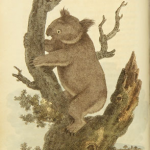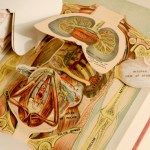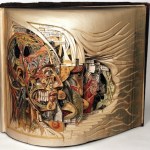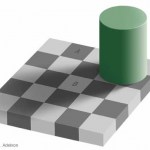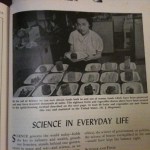Books & Essays
From 1810-11, architect and amateur naturalist George Perry published The Arcana, a lavishly illustrated, serial natural history magazine. Although Perry intended for the serial issues to be assembled by his subscribers into a book, only thirteen complete copies are known to survive today. More than a third of the known copies are in Australia - perhaps fittingly, as Perry was the first to publish an illustration of the koala (above).
Perry's work is not well known; in researching this post, all I could find online were auction listings and occasional references to a recent facsimile…
This little video from Abebooks is the closest I've ever gotten to flipping through a copy of the Codex Seraphinianus. What a truly weird book.
I particularly love it when the staid narrator reveals his "favorite" illustration - a roller skater murdered by a monstrous pen. What?!
The Codex reminds me of If You're Afraid of the Dark, Remember the Night Rainbow by Cooper Edens. My mom had a copy and I used to flip through it as a child, confused and not a little disturbed. I still took things too literally to appreciate the visual non sequiturs, combined with the nonsensical text ("If you…
The most beautiful experience we can have is the mysterious. It is the fundamental emotion which stands at the cradle of true art and true science. Whoever does not know it can no longer wonder, no longer marvel, is as good as dead, and his eyes are dimmed.
Albert Einstein
Ideas and Opinions, New York: Crown, 1954.
(quoted in Lawrence Weschler's Mr. Wilson's Cabinet of Wonder: Pronged Ants, Horned Humans, Mice on Toast, and Other Marvels of Jurassic Technology, New York: Random House, 1995.)
Animated Anatomies, a new show at the Perkins Library at Duke University, explores the tradition of fold-out or pop-up paper anatomical diagrams:
Animated Anatomies explores the visually stunning and technically complex genre of printed texts and illustrations known as anatomical flap books. These publications invite the viewer to participate in virtual autopsies, through the process of unfolding their movable leaves, simulating the act of human dissection. This exhibit traces the flap book genre beginning with early examples from the sixteenth century, to the colorful "golden age" of…
They're doing exactly what we always complain our brightest students don't do: eschewing the easy bucks of Wall Street, consulting or corporate law to pursue their ideals and be of service to society. Academia may once have been a cushy gig, but now we're talking about highly talented young people who are willing to spend their 20s living on subsistence wages when they could be getting rich (and their friends are getting rich), simply because they believe in knowledge, ideas, inquiry; in teaching, in following their passion. To leave more than half of them holding the bag at the end of it all…
Physicists are ontological detectives. We think of scientists as wholly rational, open to all possible arguments. But to begin with a conviction and then to use one's intellectual prowess to establish support for that conviction is a methodology that really has worked for scientists, including Deutsch. One could argue that he dreamed up quantum computing because he was devoted to the idea that science can explain the world. Deutsch would disagree. In "The Fabric of Reality," Deutsch writes, "I remember being told, when I was a small child, that in ancient times it was still possible to know…
Ok, what are the people at Quirk Books on?
I have to say, I love the cover of the book, and the typographical trailer is cute - but isn't this just blatant meme abuse?
Quirk explains The Meowmorphosis thus. . .
"One morning, as Gregor Samsa was waking up from anxious dreams, he discovered that he had been changed into an adorable kitten." Thus begins The Meowmorphosis--a bold, startling, and fuzzy-wuzzy new edition of Franz Kafka's classic nightmare tale, from the publishers of Pride and Prejudice and Zombies! Meet Gregor Samsa, a humble young man who works as a fabric salesman to support…
From Linda Holmes, a poignant post about how the deluge of information makes it impossible to scratch the surface in a single lifetime:
there are really only two responses if you want to feel like you're well-read, or well-versed in music, or whatever the case may be: culling and surrender.
Culling is the choosing you do for yourself. It's the sorting of what's worth your time and what's not worth your time. It's saying, "I deem Keeping Up With The Kardashians a poor use of my time, and therefore, I choose not to watch it." It's saying, "I read the last Jonathan Franzen book and fell asleep…
Wait - did Peter Nowogrodski just shoehorn everything I love into one meandering, indulgent multimedia essay??*
Tolkien's Shire appears as a coherent ecosystem, cradled by productive fields and populated by abundant orchards, caches of edible mushroom, and even the fishable Bywater Pool, ornamented with an authentic churning mill. The land at Hobbiton is changing still: Jackson's crowning oak tree now sits in sun-scarred pieces behind a rotten wooden fence at the termination of Bagshot Row, a home for the welcome swallows that course through air above. In the pastures opposite Bag End, a…
Shambling, slowly disintegrating zombies aren't good for much - but maybe they're helpful for teaching neurobiology?
The Zombie Autopsies with Steven Schlozman, MD from GCP authors on Vimeo.
It is all about braaaaiiiiiinnns, after all. . . .
Read all about Zombie Autopsies here, or head to Amazon.
And I do mean Dreadful.
In honor of Zombiefest, which is a totally random blogholiday I made up, and all my awesome readers, the first person to email me their US mailing address gets a copy of Pride and Prejudice and Zombies: Dreadfully Ever After. Wow - that took longer than I expected. :)
I have a copy of "Alternative Careers in Science: Leaving the Ivory Tower" (1998 edition) that I'll mail to the first person who emails me their (US) address. Sorry, It's taken!
O designer-readers who like to work and play with Photoshop, this contest may be up your alley: Quirk Books, the outfit behind Pride and Prejudice and Zombies, has joined with Bridgeman Art Library to invite submissions for its "Art of the Mash-Up" competition. Basically, they want you to prove you can do better than the Regency unmentionable pictured above:
The iconic "Zombie Lady" on the cover of the New York Times Best Seller Pride and Prejudice and Zombies captured the imagination of readers around the world and has become one of the most recognizable book jackets in recent history.…
Lest any of my faithful readers think they're the only ones whose wonderful linky suggestions I don't seem to get around to posting, my boyfriend sent me this and I didn't post it, and apparently it's on the Daily Dish and 3QD today & he's all like "why didn't you post it sooner? Didn't you get my email??"
Sigh.
So for the record: Brian Dettmer is amazing. He makes these sculptures by carving away - not adding or repositioning - the pages of old illustrated books. And another thing that's really cool: letting the blogosphere (that's me!) disseminate and respond to his work is part of…
Psychologist Robert Kurzban's new book promises to explain Why Everyone (Else) Is a Hypocrite. It's a bold promise, and I was skeptical when first invited to review it. But Kurzban delivered - hilariously, entertainingly so. Although since I agree with almost everything he writes, I may not be the most objective of critics. (FYI: this is a long review, so if you're short on time, you can skip to the end of the post, and watch the author's short video trailer about the book. Cheers.)
For starters, Kurzban has convinced me to be more careful when I talk and write about my brain (and yours).…
I found this children's encyclopedia in a pile of books on the curb a few weeks ago. Some of its depictions of science are charming; some are odd, and all are really, really dated. More snapshots below the fold. . .
The NYT has a great little article about Chevalier Jackson, a turn-of-the-century doctor who kept a collection of foreign objects removed from people's throats. Dr. Jackson
"preserved more than 2,000 objects that people had swallowed or inhaled: nails and bolts, miniature binoculars, a radiator key, a child's perfect-attendance pin, a medallion that says "Carry me for good luck." . . . He was so intent on assembling his collection that he once refused to return a swallowed quarter, even when its owner threatened his life."
On February 18, the Mutter Museum, which owns Jackson's collection,…
Here are some essay links I've had open as tabs in my browser for over a week, waiting to be posted. Unfortunately, I don't have time to do the extensive commentary they deserve, so I'm admitting that, and just posting them already. Enjoy.
Graphical Abstracts & Biologists as Designers
Andrew Sun discusses "graphical abstracts" at nature network:
Although they are irrelevant to the quality of the research in my opinion, graphical abstracts (GAs) are in fact increasingly appreciated nowadays. No matter you like them or not, chances are that you have to draw one in order to publish your…
This series of sciart wallpapers by Dan Funderburgh were inspired by the Time-Life Science Library, a series of educational books published in the 1960s. For those of us old enough to remember them, Time-Life's series are objects of nostalgia in themselves. Coupling the vintage design and palettes of those books with vintage sci-art symbolism yields a sharply contemporary set of prints.
Funderburgh describes his work as "a repudiation of the fabricated schism between art and decoration;" you could also describe it as a repudiation of the fabricated gulf between science and design. (Fun…
Because people have been discussing Google ngrams a lot, and because there are always major caveats to new datamining methodologies, I have to link Natalie Binder's excellent series of posts urging caution, not only about the methodology, but about assuming too much about ngrams' utility in social research.
Binder says,
The value of the Ngrams Viewer rests on a bold conceit: that the number of times a word is used at certain periods of time has some kind of relationship to the culture of the time. For example, the fact that the word "slavery" peaks around 1860 suggests that people in 1860…
